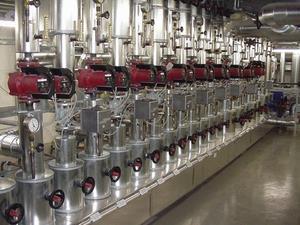This month’s product focus begins with a look at five key aspects of pump replacement by David Seymour, technical director of Grundfos Pumps
In most commercial premises pumps require replacement roughly every 15 years, and this is usually done with a “like for like” solution: job done.
However, this maintenance period is an opportunity to review the system and make sure it is delivering the most efficient solution for a building’s particular requirements.
So, what are the key areas that should be taken in consideration?
1. Are the pumps correctly sized?
All circulators and booster pump applications were sized for an original duty of flow against a pressure. The first consideration often is, is the pump suitable for the current duty requirements, particularly if the building has undergone change?
The pump may be oversized and nameplate information may not reflect the current operating duty and hence the replacement duty requirements.
A review of the current system requirements will often lead to a more efficient pump selection, with the benefit of reduced energy consumption.
2. Is there a more energy efficient solution?
Heating and cooling circulator pumps form the majority of the replacement market. The market today favours the use of glandless circulators for heating applications because of their compact nature and low maintenance demands.
Glanded mechanical seal style products are, however, more efficient and can be fitted as direct replacements for glandless circulators in some cases.
Where conventional motors are used, these should also be EFF1 or better. Some manufacturers offer these as standard for fixed speed solutions.
For variable volume systems, permanent magnet circulators are often today’s preferred choice. They deliver significant energy savings over older style pumps as they self-adjust to the demands of the system.
3. How important is ease of service?
For glandless circulators the replacement heads are readily available and are simple to change. On glanded pumps the two main service items are the motor and the mechanical seal.
Today’s pump designs facilitate easier replacement of worn components. The choice of a major manufacturer who is able to provide service for the long term is important, as it will have a wide range of dedicated service kits and replacement motors available.
4. What solution will offer the least pipework modifications?
With space at more and more of a premium, the choice of in-line or end-suction style products is important.
For example, access to the motor is important, therefore sufficient space should be allowed for instances where cranes or hoists may need to be used.
5. When do you want to exchange the pumps?
Ideally, the timing of pump replacement should be planned: for example, it makes sense to replace heating stock in the summer months.
However, emergencies do occur and then it is important to ensure you are getting the best longer-term solution, but with readily available stock.
This is where reputable pump manufacturers will be able to advise and assist with the best technical solution.
Source
�ڶ����� Sustainable Design


















No comments yet